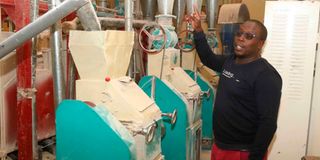Karatina family eyeing the millions in the milling sector

John Mwangi, who runs Salama Millers with his three siblings. The milling company located in Karatina town, Nyeri County started operations in 2015.
What you need to know:
- Salama Millers, located in Karatina town, is gradually becoming a household name in Nyeri County.
- The company has four millers where the maize is sifted through to produce the final product.
After observing the millions that those in the milling business were making year after year, in 2009, Maina Mwangi and his wife Ann Njeri decided that they wanted a piece of the action.
Given that ugali is a staple food in many homes in Kenya, maize flour was the natural place to start for the couple when they set up Salama Millers. Besides milling and selling maize meal, they decided to use the by-products to produce animal feeds as well.
Their mill, located in Karatina town, is gradually becoming a household name in Nyeri County. With a vision to make it a family business, the couple incorporated their three children, Loise Wanjiku, John Mwangi and James Muriuki into the business and left the running of the company to them. The couple are dormant directors.
“In 2016, Salama Millers was registered as a company, and each of us became a director with equal shares in the company,” Muriuki, the last born, says, explaining that at the setting up of the company, all three of them had completed their university education.
Muriuki is in charge of ensuring the quality of the final product. With a background in mechanical engineering, he is also in charge of maintenance of the machines.

John Mwangi, who runs Salama Millers with his three siblings. The milling company located in Karatina town, Nyeri County started operations in 2015.
Mwangi, the second born, is charged with the duty of sourcing the maize from farmers and wholesalers. He has to ensure that the maize is of high quality before buying.
“We get at least 28 tons of maize every day, which is the capacity of our factory at the moment – we source most of the maize from individual farmers,” Mwangi explains.
Mwangi, who also oversees the animal feeds department, outsources other products that are needed to make the animal feeds. These include sunflower cake, soya DOC, wheat bran and rice polish. Before processing, the maize passes through a nutritionist who does random sampling.
“The nutritionist checks for any toxins in the maize such as aflatoxin and gives the green light to start the milling process if satisfied,” he explains.
The maize is then taken through the cleaning process, which involves sorting and removing chaff, soil, corn and other unwanted substances. They then move to the destoning process, which involves removing the stones and particles, completely cleaning the maize,” he adds.
The clean maize then goes through the degerming process where maize germ, an animal feed, is produced as a byproduct before starting the actual milling process. The degermed maize is then taken to the roller mills for processing. The company has four millers where the maize is sifted through to produce the final product.
Animal feeds
“The sifted flour is then moved to packaging where it is hand-packaged by more than 30 employees.”
The process produces maize germ and maize bran as by-products which are used for the production of animal feeds.
“The same nutritionist does the formulation on different animal feeds like the layers mash, kienyeji mash, sow and weaner, chick mash, growers mash, dairy meal, high yield dairy meal and poland mix and advises us which to buy,” he says.
The products are then handed over to Wanjiku, the company’s finance manager and also the person that oversees the distribution of their brand of maize flour to sales agents across the region.
For this family, working together has strengthened the company since they are able to work as a team, perfect their areas and in the process grow the company. In the near future, the siblings plan to expand production, the aim to increase the amount of flour produced per day.





